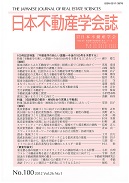Volume 26, Issue 1
Displaying 1-34 of 34 articles from this issue
- |<
- <
- 1
- >
- >|
-
2012Volume 26Issue 1 Pages 4-5
Published: June 25, 2012
Released on J-STAGE: October 26, 2016
Download PDF (161K) -
2012Volume 26Issue 1 Pages 6-9
Published: June 25, 2012
Released on J-STAGE: October 26, 2016
Download PDF (231K) -
2012Volume 26Issue 1 Pages 10-12
Published: June 25, 2012
Released on J-STAGE: October 26, 2016
Download PDF (208K) -
2012Volume 26Issue 1 Pages 13-17
Published: June 25, 2012
Released on J-STAGE: October 26, 2016
Download PDF (253K) -
2012Volume 26Issue 1 Pages 18-21
Published: June 25, 2012
Released on J-STAGE: October 26, 2016
Download PDF (259K) -
2012Volume 26Issue 1 Pages 22-34
Published: June 25, 2012
Released on J-STAGE: October 26, 2016
Download PDF (439K) -
2012Volume 26Issue 1 Pages 35-37
Published: June 25, 2012
Released on J-STAGE: October 26, 2016
Download PDF (214K) -
2012Volume 26Issue 1 Pages 38-46
Published: June 25, 2012
Released on J-STAGE: October 26, 2016
Download PDF (470K) -
2012Volume 26Issue 1 Pages 47-
Published: June 25, 2012
Released on J-STAGE: October 26, 2016
Download PDF (547K) -
2016Volume 26Issue 1 Pages 51-55
Published: June 25, 2016
Released on J-STAGE: October 26, 2016
Download PDF (518K) -
2012Volume 26Issue 1 Pages 56-60
Published: June 25, 2012
Released on J-STAGE: October 26, 2016
Download PDF (717K) -
2012Volume 26Issue 1 Pages 61-63
Published: June 25, 2012
Released on J-STAGE: October 26, 2016
Download PDF (206K) -
2012Volume 26Issue 1 Pages 64-65
Published: June 25, 2012
Released on J-STAGE: October 26, 2016
Download PDF (141K) -
2012Volume 26Issue 1 Pages 66-70
Published: June 25, 2012
Released on J-STAGE: October 26, 2016
Download PDF (792K) -
2012Volume 26Issue 1 Pages 71-75
Published: June 25, 2012
Released on J-STAGE: October 26, 2016
Download PDF (247K) -
2012Volume 26Issue 1 Pages 76-80
Published: June 25, 2012
Released on J-STAGE: October 26, 2016
Download PDF (209K) -
2012Volume 26Issue 1 Pages 81-85
Published: June 25, 2012
Released on J-STAGE: October 26, 2016
Download PDF (776K) -
2012Volume 26Issue 1 Pages 86-91
Published: June 25, 2012
Released on J-STAGE: October 26, 2016
Download PDF (365K) -
2012Volume 26Issue 1 Pages 92-97
Published: June 25, 2012
Released on J-STAGE: October 26, 2016
Download PDF (294K) -
2012Volume 26Issue 1 Pages 98-103
Published: June 25, 2012
Released on J-STAGE: October 26, 2016
Download PDF (1313K) -
2012Volume 26Issue 1 Pages 104-111
Published: June 25, 2012
Released on J-STAGE: October 26, 2016
Download PDF (1819K) -
2012Volume 26Issue 1 Pages 112-118
Published: June 25, 2012
Released on J-STAGE: October 26, 2016
Download PDF (727K) -
2012Volume 26Issue 1 Pages 119-126
Published: June 25, 2012
Released on J-STAGE: October 26, 2016
Download PDF (1415K) -
2012Volume 26Issue 1 Pages 127-132
Published: June 25, 2012
Released on J-STAGE: October 26, 2016
Download PDF (571K) -
2012Volume 26Issue 1 Pages 133-142
Published: June 25, 2012
Released on J-STAGE: October 26, 2016
Download PDF (1945K) -
2012Volume 26Issue 1 Pages 143-
Published: June 25, 2012
Released on J-STAGE: October 26, 2016
Download PDF (206K) -
2012Volume 26Issue 1 Pages 144-145
Published: June 25, 2012
Released on J-STAGE: October 26, 2016
Download PDF (156K) -
2012Volume 26Issue 1 Pages 146-147
Published: June 25, 2012
Released on J-STAGE: October 26, 2016
Download PDF (642K) -
2012Volume 26Issue 1 Pages 148-
Published: June 25, 2012
Released on J-STAGE: October 26, 2016
Download PDF (138K) -
2012Volume 26Issue 1 Pages 149-
Published: June 25, 2012
Released on J-STAGE: October 26, 2016
Download PDF (825K) -
2012Volume 26Issue 1 Pages 150-157
Published: September 25, 2012
Released on J-STAGE: October 26, 2016
Download PDF (1510K) -
2012Volume 26Issue 1 Pages 158-164
Published: June 25, 2012
Released on J-STAGE: October 26, 2016
Download PDF (1487K) -
2012Volume 26Issue 1 Pages 165-
Published: June 25, 2012
Released on J-STAGE: October 26, 2016
Download PDF (187K) -
2012Volume 26Issue 1 Pages 166-187
Published: June 25, 2012
Released on J-STAGE: October 26, 2016
Download PDF (2187K)
- |<
- <
- 1
- >
- >|
